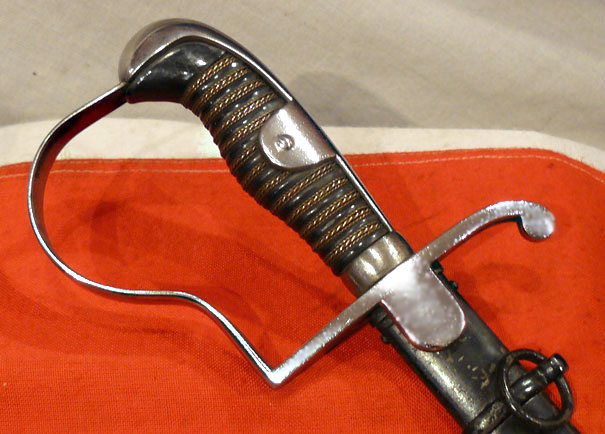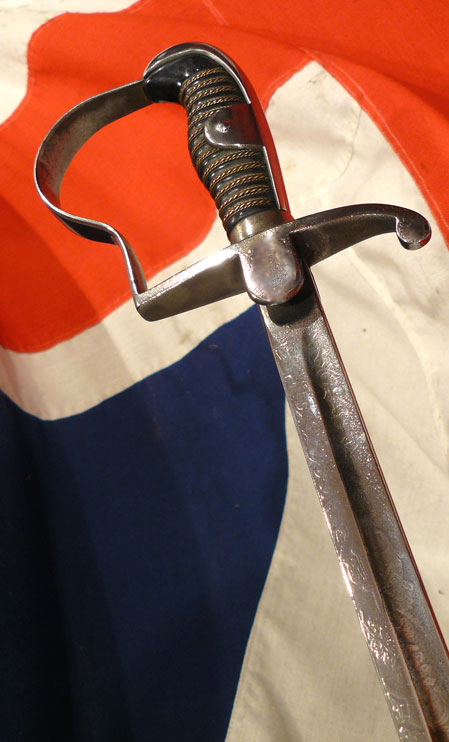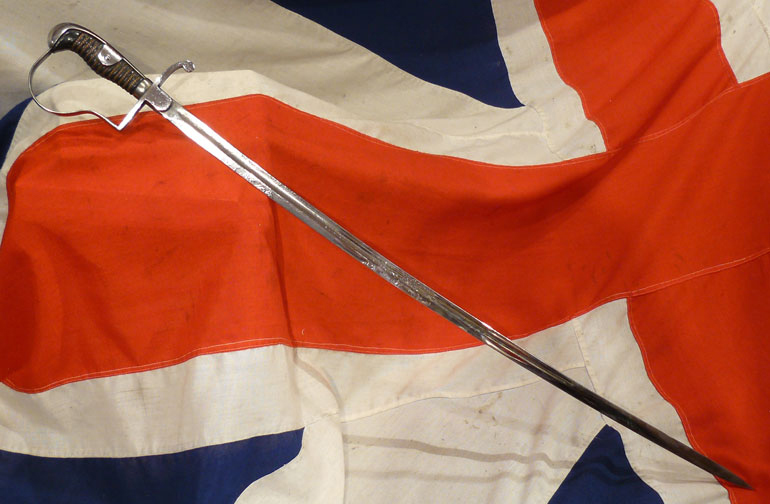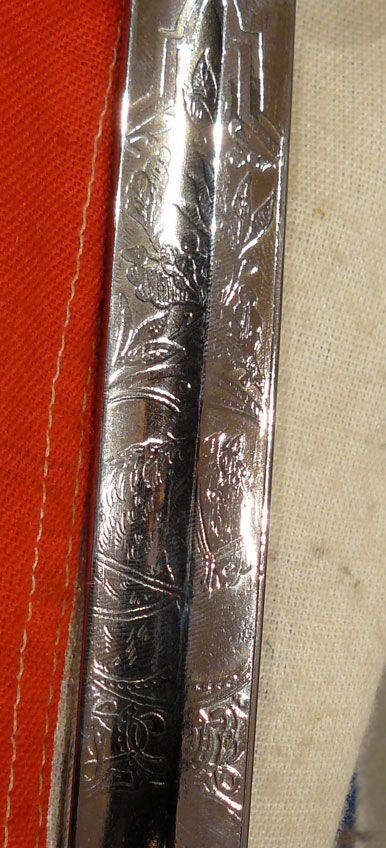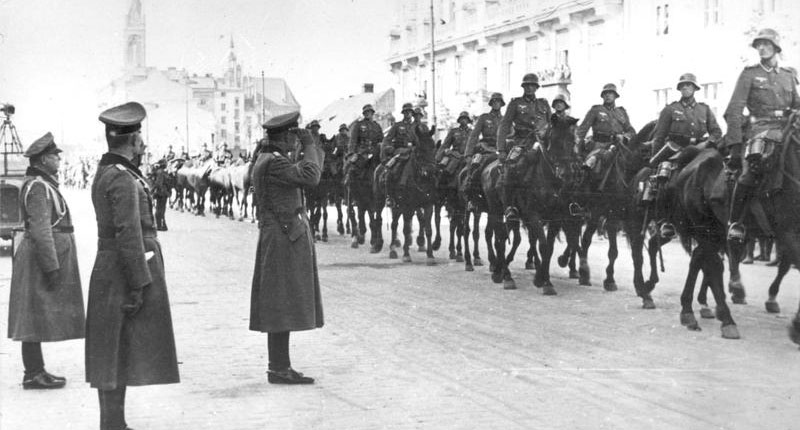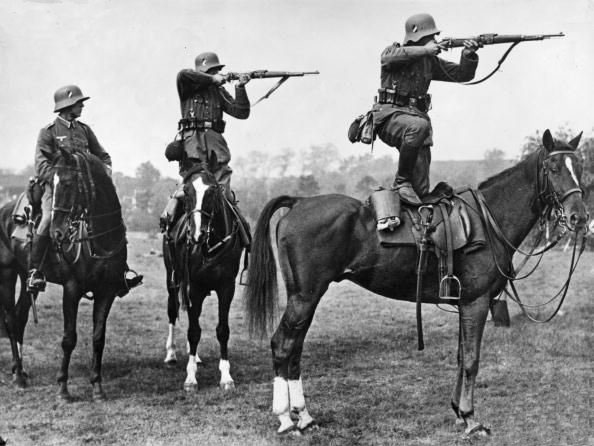A Good, & Very Rare, German Third Reich, WW2 Wehrmacht 14th Kavallerie Regimental Sword
Used in WW2. Fully etched combat blade with full regimental name of the 14th Kavallerie and an etched panel of a cavalry charge, with all the troop wearing steel combat helmets. Steel P hilt, black celluliod grip with wire binding. Black painted steel scabbard. Fully etched blade with 14th Kavallerie etched, with cavalry combat charges, a horse's head profile and florid d?cor. The same type of sword worn by General der Kavallerie Edwin Graf von Rothkirch und Trach, who joined the 14th Kavellerie, aged 42, in 1930, as a major. In September 1939 he was made Chief of the General Staff of the XXXIV Corps Command. Serving in the war for two years on the Eastern Front he was promoted in November 1944 to Commanding General of the LIII Army. General Graf von Rothkirch und Trach was captured at Neunkirchen by Lieutenant Colonel Abrams' 37th Tank Battalion in March 1945. The remnants of Graf von Rothkirch und Trachs LIII Army Corps fell back across the Rhine River but was destroyed a month later in the Ruhr pocket. Kavallerie was drawn down somewhat in the German armed forces after the French campaign, but soon after the invasion of Russia it was realised an increase in Cavalry was essential for anti-partisan policing and for recce in terrain unsuitable for vehicles. In the picture gallery their shows an original photo of a WW2 German cavalry trooper who has his identical sword mounted on his saddle. During the war German cavalry units increased in numbers from a single brigade to a larger but still limited force of six cavalry divisions and two corps HQ. All regular cavalry troops served on the Eastern Front and the Balkans and a few Cossack battalions served on the Western Front.
The German Army of 1941 had a single cavalry division assigned to Heinz Guderian's panzer group. Continuously engaged against Soviet troops, it increased in size to six regiments and in the beginning of 1942 was reformed into the 24th Panzer Division that later perished in the Battle of Stalingrad. In April?June 1943 the Germans set up three separate cavalry regiments (Nord, Mitte, S?d) ? horse units reinforced with tanks and halftrack-mounted infantry. In August 1944 these regiments were reformed into two brigades and a division forming, together with the Hungarian 1st Cavalry Division, Gustav Harteneck?s Cavalry Corps that operated in Belorussia. In February 1945 the brigades were reformed into cavalry divisions (German stud farms in East Prussia were not affected by the Allied air raids that crippled German industry
The SS operated both paramilitary horse units (23 cavalry regiments in 1941) and military Waffen SS cavalry. The SS Cavalry Brigade, formed in 1940, was engaged against civilians and guerrillas in the occupied territories and then severely checked by the Soviet Rzhev-Sychevka offensive. In 1942 the SS reformed the brigade into the 8th SS Cavalry Division manned by volksdeutsche, which operated on the Eastern Front until October 1943. In December 1943 the 8th Cavalry spun off the 22nd SS Cavalry Division manned with Hungarian Germans. These divisions were properly augmented with heavy, field and anti-aircraft artillery. Another SS cavalry division, the 33rd Cavalry, was formed in 1944 but never deployed to full strength.
The Germans recruited anti-Soviet cossacks since the beginning of Operation Barbarossa, although Hitler did not approve the practice until April 1942. Army Cossacks of 1942 formed four regiments and in August 1943 were merged into the 1st Cossack Division (six regiments, up to 13,000 men) trained in Poland and deployed in Yugoslavia. In November 1944 the division was split in two and reformed into the XVth Cossack Corps. The Kalmyks formed another cavalry corps, employed in rear guard duties.
In February 1945 German and Hungarian cavalry divisions were thrown into the Lake Balaton offensive; after a limited success, German forces were ground down by the Soviet counteroffensive. Remnants of Army cavalry fell back into Austria; 22,000 men surrendered to the Western allies, bringing with them 16,000 horses. Remnants of SS cavalry, merged into the 37th SS Division, followed the same route
Expected areas of service wear to the scabbard paint and light surface pitting on areas of the blade and hilt. Very bright polished overall
Code: 21358
1250.00 GBP


